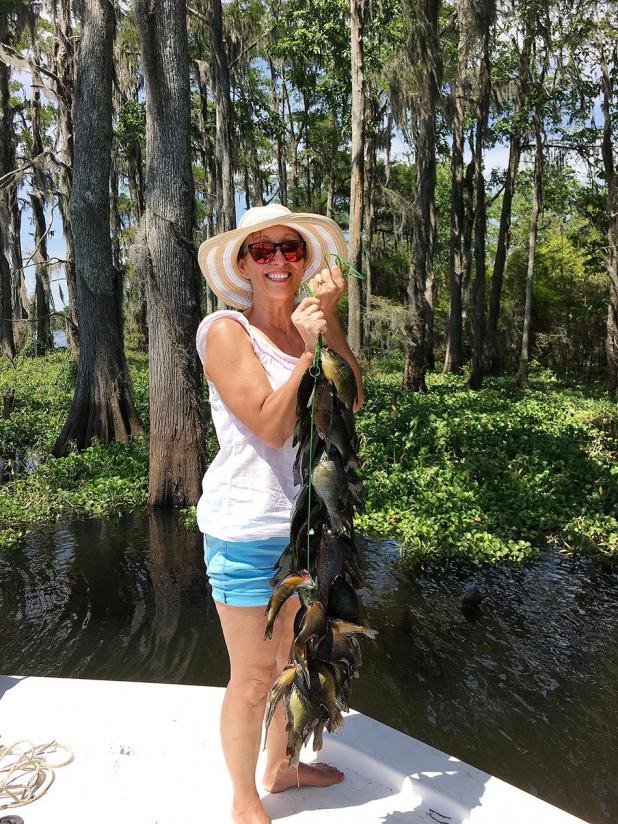
Christine Flores, the author’s wife, with a mess of late summer bream they caught in the Atchafalaya Basin.
—John Flores Photo
Falling water means good bream fishing in August
There are two benches secured to the wharf on the Morgan City side of the Atchafalaya River. They haven’t been sat in in months, because much of the year they’ve been submerged beneath the river’s flood water.
During my morning commutes to work, I have purposely driven in the right lane while passing over the E.J. “Lionel” Grizzaffi Bridge, where I could look below and catch a glimpse of the benches. Finally, this week, after months and months of fretting, the benches are completely out of the water.
I fretted because, like a lot of people, I have my favorite fishing locations. Moreover, maybe it’s my age, or maybe it’s my stubbornness, but I’m not one that likes too much change. Essentially, in the Atchafalaya Basin, there are places in Flat Lake, Bear Bayou and Big Bayou Jesse where my wife and I can sit on anchor and load the ice chest up with bream.
Below Berwick there are numerous canals within a 5 minute boat ride, where bluegills, chinquapins and goggle eyes bite throughout the spring and summer months. It’s the same out of Wilson’s Landing in Patterson, where there are more canals. And, south of Centerville, in the Quintana oil field canals as well.
Oh sure, I could have gone east these past few months and launched out of Bob’s Bayou Black Marina and fished for bream in the Copasaw and Bluebird canals, but that seemed like a whole lot more effort. What we have here in St. Mary Parish is simply easy pickings, when it comes to bream fishing.
During the month of August in years past, I have readied my boat the evening before and hustled home from work the next day for a quick midweek trip to one of my favorite locations. Usually, in that last hour before sunset, the bite turns on in a frenzy-like fashion. I have filled the ice chest with thick-sided chinquapins and big red-eyed goggle eyes in short order.
The problem with high water locally is it really spreads the fish out, which long term is not really a bad thing. When the water goes over the bank, spawning bream have less competition for laying beds and less predation.
Typically, what anglers experience is bumper numbers of fish in subsequent years post flood. It may mean having to cull a few small fish for every one you keep during those banner years, but that’s just good conservation. You should always leave enough for seed.
The trouble with subsequent years is it doesn’t take care of the immediate urge to be on the water, not to mention a hankering for a fish fry. But, now that the river is finally falling below 7 feet and into the 6 foot minor flooding stage, it appears it’s heading in the right direction where the possibility of cooking up a few bream is imminent before summer ends.
So, what to look for? In the basin, the sweet spot for me is the 5-foot depth, give or take an inch or two, which may not matter to you. There are some really good anglers out there that can find fish at any depth in an ocean. They’re simply great fishermen and have a gift.
Another thing I like is a little bit of moving water. Hard falling tides in the marsh seem to be a bit faster than in the basin. For bream in the marsh, I tend to set up near, but not on the drain, and cast to the edges where the water is a bit slower. If there is some sort of structure, all the better.
The fish are generally hungry, but still need cover to escape predators, plus they need a little something to reduce the current in order to burn less energy. Theirs’ is a dog eat dog world, where one mistake means life is over.
Up in the basin, more often than not, the water doesn’t fall so dramatically like it does in the marsh, where the tide drops a foot in just a couple hours sometimes. I still sit on anchor, but in the basin, I can toss a cork with a worm on it up current and by the time it slowly floats out of the drain, I’ve got a fish hooked in most cases.
I’ll also fish around cypress and tupelo trees in the basin as the water flows around them. On the back side of those trees are sure-fired locations to hook up with a chinquapin that measures half way up your wrist or even pick up a few sac-a-lait.
I have to admit, I’m a guy who prefers to fish with bait whether I’m in fresh or saltwater. That’s not to say I don’t chuck baits or bang the banks with them when I’m fishing — I do. But, I just like to watch a balsa wood float spring bobber, with a little split shot set 12-15 inches above a bait hook get pulled deep below the surface by a big, fat chinquapin. I can do that over and over again and never get tired of it.
I’m fairly confident that towards the latter part of August the river will be close to my 5 foot sweet spot. And, I’m sure over the next few weeks when I cross the bridge in the morning there’ll be people finally sitting on those benches again, too.
EDITOR’S NOTE: Flores is The Daily Review’s outdoor writer.
